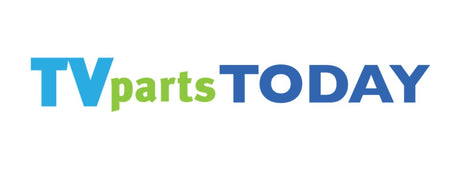Television has transformed dramatically since its earliest experimental days. What began as a mechanical system with rotating disks and dim, unstable images evolved into the digital smart displays we rely on today. Every stage of this evolution introduced new technologies, new components, and new repair strategies. Understanding how television developed over time not only enriches the story behind the screens we use but also explains why modern TVs are surprisingly easy to repair at home. With the right knowledge and proper part matching, today’s DIY repairs are more accessible than ever.
More interested in getting started with your repair, or troubleshooting some issues? Check out our helpful YouTube video below:
The Early Foundations of Television
The earliest televisions relied on mechanical scanning techniques. Pioneers such as John Logie Baird experimented with rotating disks and reflected light to create basic images. Mechanical sets were limited in clarity and stability, but they paved the way for the shift to electronic television. Innovators like Philo Farnsworth and Vladimir Zworykin introduced electronic scanning and the Iconoscope, which quickly improved image steadiness and overall picture quality.
TVpartsToday Tip: Early television repair centered on vacuum tubes and analog wiring. Understanding these basics provides valuable foundational knowledge for anyone learning modern repair skills.
As the technology matured through the 1920s, 1930s, and 1940s, electronic CRT-based systems became the standard. Households across the world began adopting black-and-white televisions, and repair technicians had to understand CRT operations, signal flow, and basic circuitry. Even at this early stage, the modular nature of televisions made them repairable by anyone willing to learn the fundamentals.
The Rise of Black-and-White Television
Black-and-white TV changed family life and marked the moment when television became a fixture in the home. These sets delivered news, entertainment, and advertising unlike anything before. Repairing them required knowledge of cathode ray tubes, analog signals, and the layout of early electronic chassis. Although primitive by today’s standards, these televisions established the idea that TVs are fixable with the right tools and understanding.
TVpartsToday Tip: Learning how legacy TVs function builds confidence when approaching modern models, especially when tracing power flow or diagnosing display failures.
The Shift to Color TV
The introduction of color broadcasting reshaped both television technology and the repair field. Early color systems, including dot-sequential and line-sequential methods, were complex and often bulky. Engineers at CBS and Philco experimented with formats that would provide richer images while preserving compatibility with black-and-white broadcasts. Color TVs created new challenges involving color calibration, multi-stage circuitry, and component-specific alignment.
TVpartsToday Tip: Early color sets require careful handling. High-voltage areas should always be discharged properly before any repair work is attempted.
The Move From Analog to Digital
The digital transition in the mid-2000s revolutionized how viewers received content. Digital signals brought sharper resolution and improved stability, but they also rendered many analog sets dependent on converter boxes. Repair considerations shifted toward digital tuners, HDMI compatibility, and software-based problems.
The rise of smart TVs expanded repair responsibilities even further. Technicians and DIY users alike now needed to account for operating systems, firmware updates, and internet connectivity. In many cases, software resets and firmware updates resolve modern problems before hardware is even accessed.
TVpartsToday Tip: Always check for available software updates and reset the network connection before opening any smart TV. Many “hardware issues” turn out to be software conflicts.
Cutting-Edge Display Technologies
Today’s high-end televisions include OLED, QLED, 4K, and 8K displays. OLED uses self-lit pixels that allow deep blacks and impressive contrast. QLED enhances brightness and color accuracy using quantum dots. These innovations create remarkable picture quality but also demand extreme precision if a repair is needed. Replacing an OLED or QLED panel can be costly due to the specialized construction and delicacy of the display assembly.
TVpartsToday Tip: For premium panels, an extended warranty or insurance plan often costs less than a full screen replacement.
Repairing Modern TVs
Despite advancements in software and display technology, modern televisions remain highly modular. Many of the most common failures involve replaceable components such as power supply boards, T-Con boards, main boards, backlight systems, and input modules. Issues such as power failures, distorted images, missing sound, or random shutdowns often lead directly to an identifiable board that can be swapped at home using basic tools.
Before starting any repair, it is important to review warranty information and verify whether the manufacturer offers part replacement programs. When warranties do not apply, DIY repair becomes the most efficient and cost-effective option.
TVpartsToday Tip: Document each step as you remove components. Photograph board locations, label screws, and keep track of cable orientation to ensure smooth reassembly.
The Future of TV Technology and Repair
As televisions become thinner, smarter, and more technically advanced, the repair landscape continues to evolve. AI-powered diagnostics, expanded online access to original parts, and more comprehensive training resources are shaping the direction of future repair methods. While the components inside modern TVs differ from those of early mechanical systems, the core principle remains unchanged: televisions are inherently repairable.
Understanding the history of television and the evolution of its components gives today’s DIY repairers a unique advantage. Whether restoring a vintage model or replacing a modern power supply board, the knowledge behind the technology empowers users to troubleshoot issues with confidence and resolve them economically at home. TVpartsToday provides support, parts, and guidance to make these repairs accessible for every level of experience.
Need Help?
If you’re still unsure about the issue or need to replace a part, reach out to TVpartsToday. We can help you identify the exact cause of the problem and provide the right replacement part!
Would you rather watch a video? Check out our helpful Troubleshooting 101 playlist over on YouTube!
Would you rather chat with a seasoned repair expert? Head on over to our TVRepairHelp subReddit!
Need help finding the right board or part?
Call us at 930-212-1975 or browse our inventory online.
DIY-friendly parts, fast shipping, and expert support – only at TVpartsToday.

